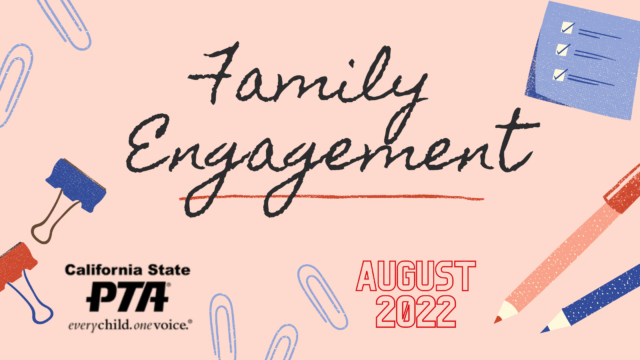By California State PTA Vice President for Family Engagement, Heather Ippolito, and California State PTA Family Engagement Consultant, Kathleen Fay

Experienced PTA leaders know that effective family engagement is key to student success. Yet, it can be challenging to briefly explain the importance of this idea to those unfamiliar with the concept.
We’re sharing a menu of suggestions so you can create your own family engagement elevator speech*. Select from each section and customize it to make an authentic summary for you. Then share it in LCAP meetings, school board meetings, advocacy days, etc., and spread the message about why family engagement is so meaningful!
___________
* Reflects the idea that it should be possible to deliver the summary in the time of an elevator ride, or between 30 seconds and two minutes.
Part 1- Family Engagement Facts (select 1 or 2). Here are a few family engagement facts to begin your elevator speech:
- Families who are engaged and offer a home environment that encourages learning are a bigger factor in student achievement than parental income, educational level, or cultural background.
- Family engagement is the concept of schools and families partnering to support children’s learning and development.
- Effective family–school partnerships offer a high return on investment that has been proven to benefit students, parents, teachers, and schools.
- Family engagement is equity work at its core, serving as a powerful lever for addressing inequities in schools and communities. It assures that educators embrace families as equal partners and are recognized as experts on their children and communities.
- Strong family engagement practices bridge the gap between home and school to help families access information and resources to support their children’s learning and advocate for their needs.
- Families possess a wealth of knowledge that should be drawn on to support students’ learning and development, helping educators to learn about each child’s learning styles, strengths, interests, and values.
- Well-informed, engaged parents make a difference in student success in school and beyond. A home environment that encourages learning is a bigger factor in student achievement than a parent’s income, education level, or cultural background. Decades of research indicate that students with involved parents are more likely to attend school regularly, perform better in school, develop better social skills, and go on to post-secondary education.
- Collaborative family and community engagement practices acknowledge that families are the greatest strengths in their children’s lives, that families have the right to be involved in their children’s education, that adult caregivers have expertise about what’s right for kids, and ensure that those directly impacted by decisions have meaningful decision-making power. Practices, systems, and structures are set up to recognize adult caregivers as full partners in education.
- PTA focuses on transformative family engagement because it represents a shared effort of families, schools, and community partners to advance programs, practices, and policies that promote children’s learning and empower every parent to make their child’s potential a reality.
Part 2- Tell your personal story (select 1). A personal connection to family engagement will make your elevator speech much more persuasive. Here are a few examples to get you thinking of your own story:
- As a parent, I remember how excited my daughter was to see me on campus. She loved that I knew her friends, that her teachers knew my name, and that I was asked to serve on committees or chaperone classroom events.
- Our PTA family engagement events, including our family art night, have helped families to feel welcomed on our campus. The number of smiles we see during these events makes all the hard work of planning worth it!
- When I moved into our new school, my child and I were so nervous, but seeing the smiling face of the PTA volunteer made us feel at ease. They explained to us about upcoming family events and shared with me the different volunteer opportunities I could participate in. That short interaction made all the difference in our day.
Part 3- The Ask (select 1). Finish up by inviting the person to learn more and get involved. Here are some examples of how to welcome others:
- Join us at the Welcome Tea to see how engaged our parent community is in our school.
- I hope to see you next week when we’ll be allowing families to offer their feedback on the proposed bell schedule changes.
- You’re welcome to participate in our next forum, where we’ll learn more about how parents can more effectively advocate on behalf of their children.
- If you want to hear some ideas about what parents can do to build/support/oppose [this matter], we’ll be getting together [day/time/place] and would appreciate your input.
- As a school board member, I think you’d be pleased to observe this partnership. We’d love to see you at our Meet the Administrators event so you can show your support for our school community.
- Improving our school’s family engagement practices would offer so many benefits to students that I think it’s worth our time to consider bringing School Smarts to our campus.
- I’m sure your kids would love to see you here with us when they hold their science fair. It’ll be fun for everyone!
To show that you are open to continuing the conversation, we recommend sharing your contact information so they can get in touch with you with any follow-up questions or suggestions. Now THAT’S being PTA-friendly!